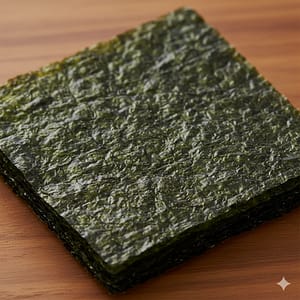- Home
- Nori Seaweed

I. General Information
A. Scientific Name:
Porphyra, Pyropia
B. Alternative Names:
Nori, Laver, Purple Laver
C. Pronunciation:
noh-ree / lay-ver
II. Sourcing and Origin
A. Source:
Harvested from shallow coastal waters in Japan, Korea, and China; cultivated on nets in tidal zones.
B. Geographic Origin:
East Asia (Japan, Korea, China); also found in temperate coasts worldwide
C. Method of Processing:
Harvested, washed, shredded, pressed into sheets, roasted or toasted
III. Properties and Uses
A. Physical Properties:
Thin, papery sheets, dark green to black; crisp when dry, soft when moist
B. Chemical Composition:
High in protein, iodine, fiber, vitamins A, B12, C; rich in minerals and antioxidants
C. Primary Uses:
Skincare: Antioxidant-rich extracts for protection
Haircare: Minerals may help scalp and hair strength
Wellness: Supports thyroid health with iodine
Culinary: Sushi wraps, soups, rice snacks
Household: Seasoning flakes for food
D. Key Benefits:
Boosts thyroid function, provides plant-based protein, antioxidant support
IV. Safety and Considerations
A. Potential Allergies:
Rare, but iodine sensitivity may cause issues
B. Best Practices for Use:
Use roasted sheets for sushi; sprinkle flakes as garnish
C. Special Precautions:
High iodine content. Must limit excessive daily consumption
V. Fun & Educational Facts
A. Historical Context:
Consumed in Japan since at least the 8th century; traditional laverbread in Wales
B. Did You Know?
Nori was once made by hand like paper before modern farming methods
C. DIY Recipe Idea:
Sushi rolls (maki)
Nori chips with sesame oil and salt
Rice balls (onigiri) wrapped in nori
